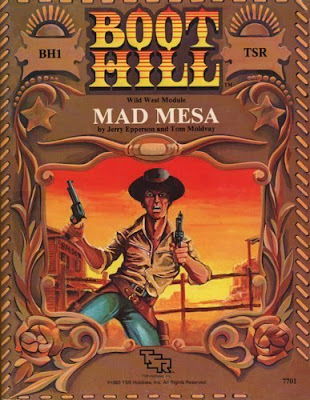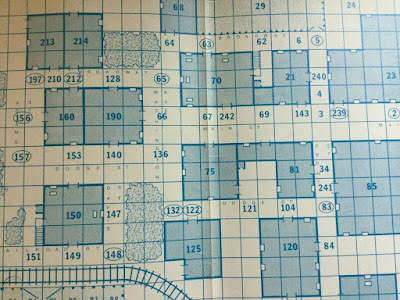Retrospective: Mad Mesa
 Every now and then, as I consider the subject of the next entry in this series, I come across one whose primary interest is not its content so much as its form. That's the case with Mad Mesa, the very first module produced by TSR in 1981 for use with Boot Hill. This fact alone makes it notable. While the module format was originally created for use with Dungeons & Dragons, TSR would eventually publish modules for all of their roleplaying lines, though most were never as extensive (or successful) as those for D&D. Boot Hill would eventually have only five modules, the lowest number, I believe, of any TSR RPG. This small number gives each published entry added weight when looking at it.
Every now and then, as I consider the subject of the next entry in this series, I come across one whose primary interest is not its content so much as its form. That's the case with Mad Mesa, the very first module produced by TSR in 1981 for use with Boot Hill. This fact alone makes it notable. While the module format was originally created for use with Dungeons & Dragons, TSR would eventually publish modules for all of their roleplaying lines, though most were never as extensive (or successful) as those for D&D. Boot Hill would eventually have only five modules, the lowest number, I believe, of any TSR RPG. This small number gives each published entry added weight when looking at it.Consider, too, the module's byline: "by Jerry Epperson and Tom Moldvay." Tom Moldvay is a name that needs no introduction to anyone reading this blog, but Jerry Epperson? Who is he? That's a good question and I wish I could provide a good answer. He seems to have been a freelance writer rather than an employee of TSR, like Moldvay. He'd later go on to contribute to a handful RPG products over the years (for GURPS, Marvel Super Heroes, and Shadowrun), but doesn't appear to have otherwise left a significant mark on the hobby. Epperson dedicates Mad Mesa to, among other people, Moldvay, "who took an idea and breathed into it the essence of life." This suggests to me that Moldvay had a much bigger hand in the final product than his secondary credit in the byline might imply.
Like most modules of the time, Mad Mesa is 32 pages long and is divided into two uneven sections, along with a map on its interior cover. Here's what part of the map looks like, because it's quite unusual:
 As you can see, there are numbered buildings, as one might expect on map of this kind. However, there are also numbers located elsewhere, such as on the streets of the titular town of Mad Mesa. Some of these numbers are circled. The numbers are all used not merely as part of a traditional map key but as entries in a solitaire adventure scenario that makes up the bulk of the module. Whenever the solo player's character enters an area with a number, he consults the appropriate entry in the book to see what he encounters. Entries with circles around them indicate "chance encounters," which is to say, a random encounter, the results of which are determined by consulting tables also in the book.
As you can see, there are numbered buildings, as one might expect on map of this kind. However, there are also numbers located elsewhere, such as on the streets of the titular town of Mad Mesa. Some of these numbers are circled. The numbers are all used not merely as part of a traditional map key but as entries in a solitaire adventure scenario that makes up the bulk of the module. Whenever the solo player's character enters an area with a number, he consults the appropriate entry in the book to see what he encounters. Entries with circles around them indicate "chance encounters," which is to say, a random encounter, the results of which are determined by consulting tables also in the book.I find it fascinating that the very first Boot Hill module contains a lengthy solitaire scenario, which takes up 24 of its 32 pages. It's doubly fascinating when you consider that the second part of the module contains a multi-player adventure that depends on the referee's having already played through the solo scenario "so that he or she can use the information to smoothly run the multi-player adventure." Indeed, the multi-player adventure is little more than a more freeform and elaborated version of the solo adventure, which involves the characters having come to the frontier settlement of Mad Mesa just as the long-simmering feud between the Russells and the Kanes – two ranching factions – boils over into violence.
As presented, both versions of the module's scenario are fairly open-ended and I dare say "Braunstein-like." The characters are caught up in the machinations of larger factions with their own agendas and it's up to the player(s) to navigate this as best they are able, even to the point of playing one faction off against another, Clint Eastwood-style. Of all of TSR's published roleplaying games, Boot Hill seems to have stayed closest to its original miniature wargaming roots and that comes across very clearly in Mad Mesa. Younger gamers or those simply unfamiliar with the history of the hobby might well find this aspect of the module strange, even off-putting, but I find it a useful reminder of where it all began.
Finally, Mad Mesa is worthy of note for one other reason: its artwork. TSR in 1981 had a remarkable and varied bullpen of illustrators and this module makes use of almost all of them. There are thus pieces by Jeff Dee, David "Diesel" LaForce, Jim Roslof, Bill Willingham, and even Erol Otus. It's an incredible lineup, all the more so because they're illustrating a western adventure rather than a fantasy or science fiction one. It's a pity that most of them wouldn't be employed by TSR much beyond the publication date of Mad Mesa, but, during the time they were there, they certainly left an impression.
James Maliszewski's Blog
- James Maliszewski's profile
- 3 followers



